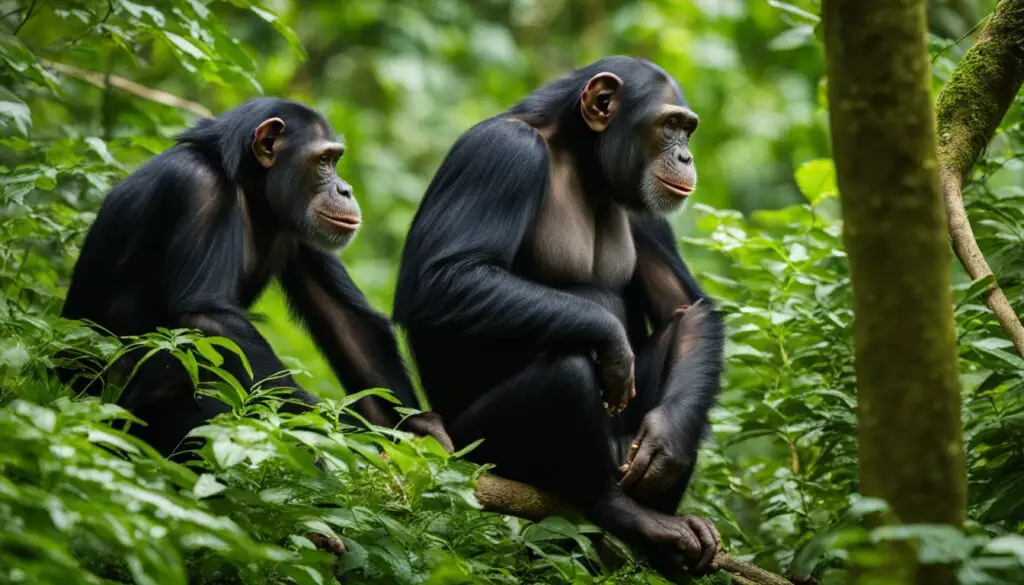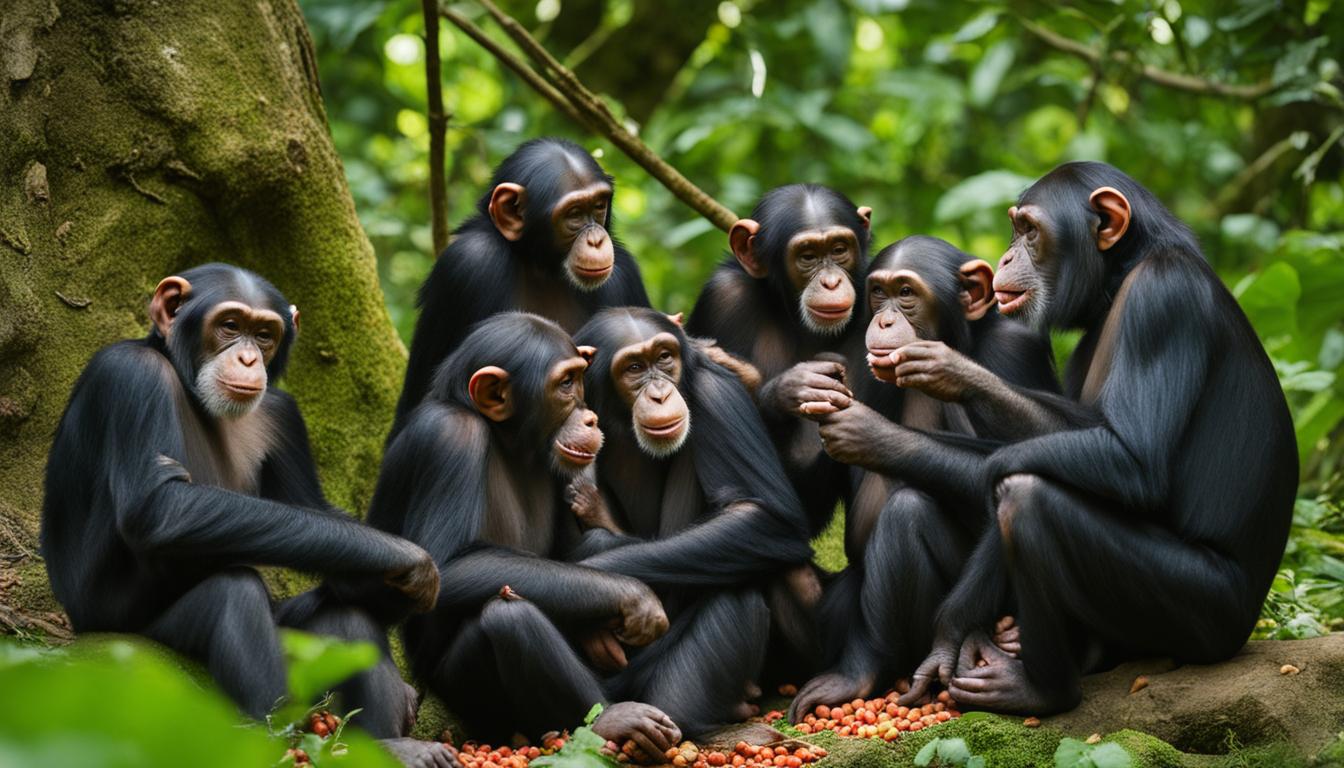Chimpanzees are fascinating creatures and share 95 to 98 percent of the same DNA with humans. They are our closest primate relatives, making them incredibly intriguing. From their ability to learn human languages like sign language to their tool-use skills, chimpanzees have captivated researchers and wildlife enthusiasts alike.
Chimpanzees can only be found in Africa, primarily in rainforest areas where they have access to water and fruits. They have a diverse diet consisting of fruits, seeds, leaves, insects, and occasionally meat. These intelligent primates have complex family and social structures, living in fission-fusion societies with strict hierarchies.
Female chimpanzees give birth once every five years and form close familial bonds with their offspring. They have the ability to walk on two legs, although they primarily move by climbing and swinging from trees. Chimpanzees can live up to their 80s, although the average lifespan is around 38 years in captivity.
Unfortunately, chimpanzees are currently an endangered species due to habitat loss and human activities. Their conservation is crucial to ensure their survival and protect their natural habitat. Let’s explore more fascinating facts about chimpanzees and learn how we can contribute to their conservation.
Chimpanzees and Humans: Close Relatives
Chimpanzees and humans share a remarkable genetic similarity, with approximately 95 to 98 percent of their DNA being identical. This makes chimpanzees our closest living relatives in the animal kingdom. There are two main types of chimpanzees: common chimpanzees (Pan troglodytes) and bonobos (Pan paniscus). While both species exhibit similar behaviors and characteristics, bonobos are known for their more peaceful and egalitarian social structure compared to their common chimpanzee counterparts.
Chimpanzees are endemic to the forests and savannahs of equatorial Africa, with a current range spanning 21 African countries. Their populations in the wild are estimated to be between 170,000 and 300,000 individuals. In the United States, there are approximately 2,000 chimpanzees, with a higher number residing in sanctuaries than in laboratories.
Chimpanzees exhibit a wide range of behaviors that are indicative of their intelligence and adaptability. They are frugivores, primarily consuming fruits, but also incorporating leaves, nuts, seeds, eggs, insects, and occasionally small mammals into their diet. Chimpanzees have been observed using tools, such as sticks to extract termites from mounds and stones to crack open nuts. They also have complex social structures, living in large communities that break off into smaller subgroups temporarily.
Overall, chimpanzees play a crucial role in our understanding of primate behavior and evolution, offering valuable insights into our own species’ origins and development. By further studying their behaviors and populations, we can continue to deepen our knowledge of both chimpanzees and ourselves.
Fascinating Behaviors of Chimpanzees
Chimpanzees, our closest primate cousins, exhibit a wide range of fascinating behaviors that showcase their intelligence and complexity. One intriguing behavior is their ability to build sleeping nests in trees using carefully-selected branches and leaves. These nests are not only comfortable but also help to prevent bacterial accumulation, as chimps build new nests every night.
| Behavior | Details |
|---|---|
| Communication | Chimpanzees communicate using a variety of gestures, facial expressions, and vocalizations to convey messages. This complex system of communication helps them express their needs, warn others of potential dangers, and navigate their social hierarchies. |
| Affection | Chimps show affection towards each other by embracing, touching hands, and even kissing. These displays of affection help to strengthen social bonds and maintain harmony within their communities. |
| Sense of Humor | Chimpanzees have been observed laughing when they engage in playful activities, showcasing a sense of humor. This behavior suggests that they experience joy and find amusement in their interactions with one another. |
| Tool Use | Chimpanzees are known for their remarkable tool-use skills. They have been observed using sticks to extract termites from mounds and stones to crack open nuts. This ability highlights their problem-solving capabilities and adaptability in their environment. |
In terms of diet, chimpanzees are primarily frugivorous, consuming a variety of fruits. However, their diet also includes leaves, nuts, seeds, eggs, insects, and occasionally small mammals. This varied diet allows them to adapt to different food sources and environmental conditions.
Aggression and Ritualistic Behaviors
While chimpanzees are intelligent and social animals, they can also display aggression and ritualistic behaviors. Aggression among chimpanzees can occur due to competition over resources or social dominance. Additionally, they have been observed engaging in ritualistic behaviors, such as throwing stones at trees. The reasons behind these behaviors are still being studied, but they provide further insight into the complexity of chimpanzee behavior.
Overall, understanding the fascinating behaviors of chimpanzees is essential for their conservation. By learning more about their habitat, diet, and social dynamics, we can better protect these incredible creatures and ensure their survival for future generations.

The Conservation of Chimpanzees
The conservation of chimpanzees is of utmost importance to ensure the survival of these incredible creatures in the wild. Chimpanzees face numerous threats, including habitat loss, hunting, and the risk of infectious diseases. To protect them, it is crucial to implement effective conservation strategies and raise awareness about their plight.
Table: Conservation Challenges Facing Chimpanzees
| Threats | Description |
|---|---|
| Habitat Loss | Deforestation and human activities are destroying chimpanzee habitats, limiting their access to food and water sources. |
| Hunting | Illegal hunting for bushmeat and the pet trade poses a significant threat to chimpanzees, resulting in population decline. |
| Infectious Diseases | Chimpanzees are susceptible to various diseases, including those transmitted by humans. The ongoing COVID-19 pandemic highlights the need for protective measures. |
Efforts to conserve chimpanzees involve both legal protection and on-the-ground initiatives. Laws are in place to safeguard chimpanzees within their range, but enforcement often falls short. Stronger regulations and better coordination of land use are necessary to protect their habitats and mitigate the impact of human activities.
Organizations like Save the Chimps and the Jane Goodall Institute play a crucial role in chimpanzee conservation. They work towards habitat preservation, rescue and rehabilitation of chimps, community education, and research. Additionally, individuals can support conservation efforts by making sustainable choices, avoiding products linked to deforestation, and donating to primate sanctuaries.
Conclusion
Chimpanzees are truly remarkable beings and hold a special place in the natural world as our closest primate relatives. Their fascinating behaviors, such as their ability to use tools and communicate with each other, highlight their intelligence and complexity. These traits make learning about chimpanzee facts an incredibly interesting endeavor.
Unfortunately, chimpanzees face the harsh reality of being an endangered species. Their habitats are rapidly disappearing due to deforestation, climate change, and human activities. This puts these incredible creatures at great risk, necessitating urgent conservation efforts to protect them and their habitats.
As individuals, we can contribute to the conservation of chimpanzees and their natural habitats. By raising awareness about the importance of protecting these creatures, choosing sustainable products, and supporting organizations dedicated to their conservation, we can make a difference. Together, we can ensure that future generations will continue to marvel at the wonder of chimpanzees in the wild.
What are some common misconceptions about chimpanzees?
Many people believe that chimpanzees are aggressive creatures, but in reality, they are quite peaceful in their natural habitat. Another misconception is that chimps are unable to communicate, when in fact they have a complex system of communication using gestures, facial expressions, and vocalizations. These are some interesting facts about chimpanzees.
FAQ
What percentage of DNA do chimpanzees share with humans?
Chimpanzees share 95 to 98 percent of the same DNA with humans.
Where can chimpanzees be found?
Chimpanzees can only be found in Africa, primarily in rainforest areas where they have access to water and fruits.
Can chimpanzees learn human languages?
Yes, chimpanzees have the ability to learn human languages like sign language.
What are some special skills of chimpanzees?
Chimpanzees are known for their tool-use skills and have been observed using tools for various tasks.
What do chimpanzees eat?
Chimpanzees are omnivorous, with a diet consisting of fruits, seeds, leaves, insects, and occasionally meat.
How do chimpanzees live socially?
Chimpanzees have complex family and social structures, living in fission-fusion societies with strict hierarchies.
How often do female chimpanzees give birth?
Female chimpanzees give birth once every five years and have close familial bonds with their offspring.
How long do chimpanzees live?
Chimpanzees can live up to their 80s, although the average lifespan is around 38 years in captivity.
How do chimpanzees move?
Chimpanzees have the ability to walk on two legs, although they primarily move by climbing and swinging from trees.
Why are chimpanzees endangered?
Chimpanzees are currently an endangered species due to habitat loss and human activities.
How many types of chimpanzees are there?
There are two main types of chimpanzees: common chimpanzees (Pan troglodytes) and bonobos (Pan paniscus).
What is the current range of chimpanzees?
Chimpanzees are endemic to the forests and savannahs of equatorial Africa, with a current range spanning 21 African countries.
How many chimpanzees are estimated to be living in the wild?
Scientists estimate that there are between 170,000 and 300,000 chimpanzees living in the wild.
How many chimpanzees are there in the United States?
In the United States, there are approximately 2,000 chimpanzees, with more living in sanctuaries than in laboratories.
What do chimpanzees eat?
Chimpanzees are frugivores, primarily eating fruits, but also consume leaves, nuts, seeds, eggs, insects, and occasionally hunt small mammals.
What are some unique behaviors of chimpanzees?
Chimpanzees have been observed using tools, engaging in ritualistic behaviors, and have complex communication and social interactions.
How do chimpanzees communicate?
Communication among chimpanzees involves gestures, facial expressions, vocalizations, and physical contact.
How do chimpanzees build their nests?
Chimpanzees build sleeping nests in trees using carefully-selected branches and leaves.
Do chimpanzees show affection towards each other?
Yes, chimpanzees show affection by embracing, touching hands, and even kissing.
Are chimpanzees endangered?
Yes, chimpanzees are currently an endangered species due to habitat loss, hunting, and infectious diseases.
How can I contribute to the conservation of chimpanzees?
You can support conservation efforts by choosing sustainable products, avoiding palm oil, and donating to primate sanctuaries.
How has the COVID-19 pandemic affected chimpanzees?
The COVID-19 pandemic has highlighted the need for protective measures to prevent the spread of diseases among chimpanzees.
Why are chimpanzees important to study and protect?
Chimpanzees are fascinating creatures and our closest primate relatives, sharing a significant amount of DNA with humans. By learning more about them and spreading awareness, we can contribute to their preservation and the conservation of their natural habitats.










